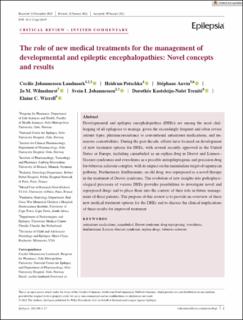| dc.contributor.author | Landmark, Cecilie Johannessen | |
| dc.contributor.author | Potschka, Heidrun | |
| dc.contributor.author | Auvin, Stephane | |
| dc.contributor.author | Wilmhurst, Jo M. | |
| dc.contributor.author | Johannessen, Svein | |
| dc.contributor.author | Trenite, Dorothee K. N. | |
| dc.contributor.author | Wirrell, Elaine | |
| dc.date.accessioned | 2021-05-28T16:01:39Z | |
| dc.date.available | 2021-05-28T16:01:39Z | |
| dc.date.created | 2021-03-04T11:45:11Z | |
| dc.date.issued | 2021-02-27 | |
| dc.identifier.citation | Epilepsia. 2021, 62 (4), 1-17). | en_US |
| dc.identifier.issn | 0013-9580 | |
| dc.identifier.uri | https://hdl.handle.net/11250/2756935 | |
| dc.description.abstract | Developmental and epileptic encephalopathies (DEEs) are among the most chal- lenging of all epilepsies to manage, given the exceedingly frequent and often severe seizure types, pharmacoresistance to conventional antiseizure medications, and nu- merous comorbidities. During the past decade, efforts have focused on development of new treatment options for DEEs, with several recently approved in the United States or Europe, including cannabidiol as an orphan drug in Dravet and Lennox– Gastaut syndromes and everolimus as a possible antiepileptogenic and precision drug for tuberous sclerosis complex, with its impact on the mammalian target of rapamycin pathway. Furthermore, fenfluramine, an old drug, was repurposed as a novel therapy in the treatment of Dravet syndrome. The evolution of new insights into pathophysi- ological processes of various DEEs provides possibilities to investigate novel and repurposed drugs and to place them into the context of their role in future manage- ment of these patients. The purpose of this review is to provide an overview of these new medical treatment options for the DEEs and to discuss the clinical implications of these results for improved treatment. | en_US |
| dc.description.sponsorship | C.J.L. has received an educational grant from GW Pharma and a speaker's honorarium from Eisai. H.P. has received research funding, consulting fees, and speaker's honoraria from Zogenix, Eisai, Bial, Roche, and MSD. S.A. has served as a consultant for or received honoraria for lectures from Arvelles, Eisai, GW Pharma, Lundbeck, Nutricia, UCB Pharma, Xenon, and Zogenix. He has been an investigator for clinical trials for Advicenne Pharma, Eisai, UCB Pharma, and Zogenix, and is an associate editor of Epilepsia. J.M.W. is an associate editor of Epilepsia. S.I.J. has no conflicts of interest to disclose. D.K.-N.T. has received research funding and consulting fees from UCB Pharma, GW Pharma, and Otsuka Pharma. E.C.W. has received consulting fees from Biocodex. | en_US |
| dc.language.iso | eng | en_US |
| dc.publisher | Wiley | en_US |
| dc.relation.ispartofseries | Epilepsia;volume 62, issue 4 | |
| dc.rights | Navngivelse-Ikkekommersiell-DelPåSammeVilkår 4.0 Internasjonal | * |
| dc.rights.uri | http://creativecommons.org/licenses/by-nc-sa/4.0/deed.no | * |
| dc.subject | Antiseizure medication | en_US |
| dc.subject | Cannabidiol | en_US |
| dc.subject | Dravet syndromes | en_US |
| dc.subject | Drug repurposing | en_US |
| dc.subject | Everolimus | en_US |
| dc.subject | Fenfluramine | en_US |
| dc.subject | Lennox–Gastaut syndromes | en_US |
| dc.title | The role of new medical treatments for the management of developmental and epileptic encephalopathies: Novel concepts and results | en_US |
| dc.type | Peer reviewed | en_US |
| dc.type | Journal article | en_US |
| dc.description.version | publishedVersion | en_US |
| dc.rights.holder | © 2021 The Authors. | en_US |
| cristin.ispublished | true | |
| cristin.fulltext | original | |
| cristin.qualitycode | 1 | |
| dc.identifier.doi | https://doi.org/10.1111/epi.16849 | |
| dc.identifier.cristin | 1895579 | |
| dc.source.journal | Epilepsia | en_US |
| dc.source.volume | 62 | en_US |
| dc.source.issue | 4 | en_US |
| dc.source.pagenumber | 1-17 | en_US |

